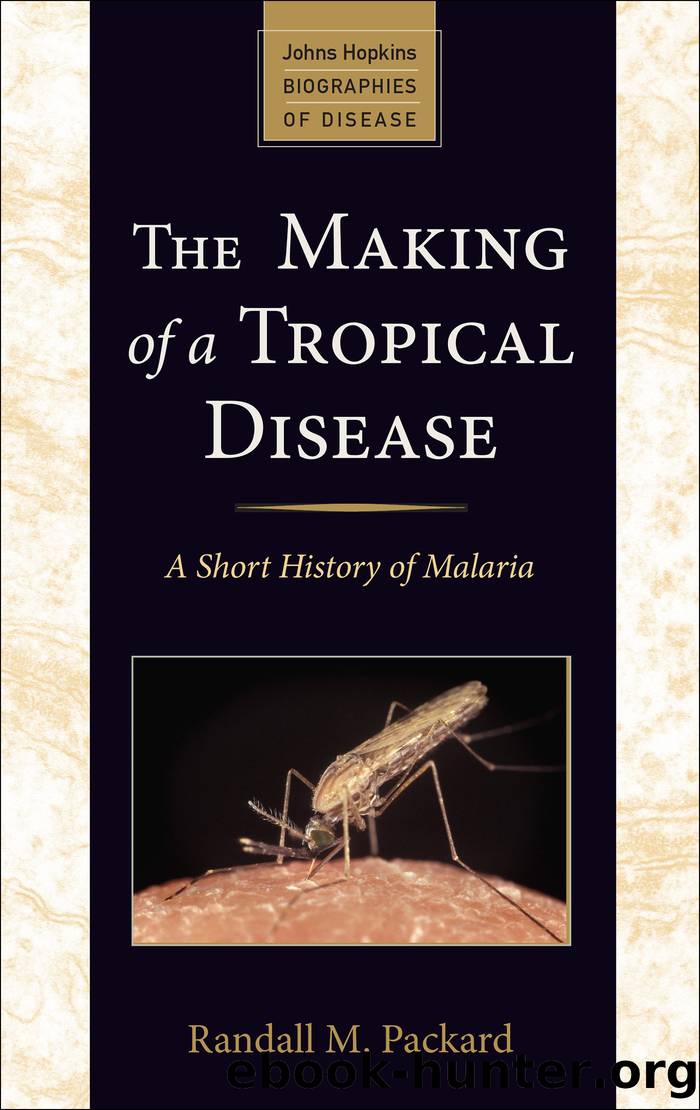The Making of a Tropical Disease by Randall M. Packard

Author:Randall M. Packard
Language: eng
Format: epub
Publisher: Johns Hopkins University Press
Published: 2018-10-14T16:00:00+00:00
Malaria Spray Team in Taiwan
Source: Agency for International Development, Malaria Meeting the Global Challenge, A.I.D. Science and Technology in Development Series (Boston: Oelgeschlager, Gunn & Hain, 1985), 43.
Others noted that in many parts of the developing world malaria control programs were poorly staffed and disorganized. This had led to the misapplication of DDT. One of the most vocal and respected supporters of the eradication strategy, Dr. Paul Russell, had firsthand knowledge of the disarray that existed in many spray programs and of the administrative difficulties that stood in the way of eradication efforts. He nonetheless pushed for the adoption of the eradication proposal.
At the time that the eradication resolution was passed, few of those who supported eradication believed that it could be achieved in sub-Saharan Africa in the foreseeable future, even though the overwhelming majority of malaria cases and deaths occurred in this region. Logistical problems, limited public health capacity, and the high vectorial capacity of the primary malaria vector, the A. gambiae mosquito, led Paul Russell and George Macdonald to conclude that malaria eradication in Africa would have to wait for years. Few eradication supporters seemed to acknowledge, however, that without a strategy for eradication in Africa, the global eradication of malaria was an unrealistic dream.
No one knew just how much eradication would cost or how the funds would be raised. The WHO estimated that it would cost $600 million for the first five years. This estimate was subsequently increased to $1,806 million in 1963. Many doubted that sufficient funds would ever be available. Most of the countries in which malaria was a problem were poor and unable to fund even normal control programs. Supporters of eradication countered that eradication represented a large up-front capital investment that would be quickly returned by the elimination of long-term recurrent expenses associated with maintaining control measures indefinitely. It was also argued that eradicating malaria would remove a major barrier to economic growth in the developing world.
Underlying all of these concerns was the question that public health officials had debated since the beginning of the century: could eradication be achieved in underdeveloped, resource-poor environments? Or, put in the terms of the earlier debate, could malaria be eliminated without simultaneous social and economic development?
Finally, and perhaps most importantly, there was growing evidence that vector resistance to DDT and other pesticides was increasing, threatening the ability of health authorities to keep malaria under control. However, rather than raising concerns about the feasibility of the proposal, this fact served to further justify the launching of an eradication campaign. Eradication had to be executed before the central weapon against malaria was no longer viable. The director general concluded that âThere is . . . no other logical choice: malaria eradication is clearly indicated, presents a unique opportunity and should be implemented as rapidly as possible. Time is of the essence.â3 The global strategy for the eradication of malaria was thus a race against time in which the WHO was gambling that malaria could be eliminated before vector resistance precluded this possibility.
Download
This site does not store any files on its server. We only index and link to content provided by other sites. Please contact the content providers to delete copyright contents if any and email us, we'll remove relevant links or contents immediately.
| Administration & Medicine Economics | Allied Health Professions |
| Basic Sciences | Dentistry |
| History | Medical Informatics |
| Medicine | Nursing |
| Pharmacology | Psychology |
| Research | Veterinary Medicine |
When Breath Becomes Air by Paul Kalanithi(7264)
Why We Sleep: Unlocking the Power of Sleep and Dreams by Matthew Walker(5642)
Paper Towns by Green John(4169)
The Immortal Life of Henrietta Lacks by Rebecca Skloot(3826)
The Sports Rules Book by Human Kinetics(3588)
Dynamic Alignment Through Imagery by Eric Franklin(3489)
ACSM's Complete Guide to Fitness & Health by ACSM(3469)
Kaplan MCAT Organic Chemistry Review: Created for MCAT 2015 (Kaplan Test Prep) by Kaplan(3423)
Introduction to Kinesiology by Shirl J. Hoffman(3301)
Livewired by David Eagleman(3123)
The River of Consciousness by Oliver Sacks(2992)
Alchemy and Alchemists by C. J. S. Thompson(2912)
The Death of the Heart by Elizabeth Bowen(2901)
Descartes' Error by Antonio Damasio(2732)
Bad Pharma by Ben Goldacre(2730)
Kaplan MCAT Behavioral Sciences Review: Created for MCAT 2015 (Kaplan Test Prep) by Kaplan(2492)
The Gene: An Intimate History by Siddhartha Mukherjee(2491)
The Fate of Rome: Climate, Disease, and the End of an Empire (The Princeton History of the Ancient World) by Kyle Harper(2436)
The Emperor of All Maladies: A Biography of Cancer by Siddhartha Mukherjee(2431)
